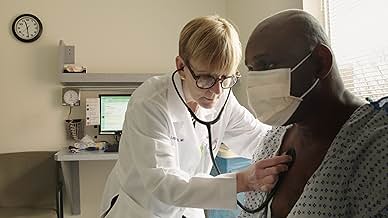IMDb-BEWERTUNG
7,7/10
1410
IHRE BEWERTUNG
Füge eine Handlung in deiner Sprache hinzuMedical docuseries focusing on patients with unique illnesses and their journeys to find a diagnosis and cure.Medical docuseries focusing on patients with unique illnesses and their journeys to find a diagnosis and cure.Medical docuseries focusing on patients with unique illnesses and their journeys to find a diagnosis and cure.
Folgen durchsuchen
Empfohlene Bewertungen
Some of the cases are fascinating, and the presentation is fine. There is some interesting human drama to observe in the way patients and family members behave through the process as well. I think my primary issue with the storytelling is just that they haven't allowed enough time to elapse to actually assess whether significant progress was made. That left almost all the cases with a feeling that nothing had really been resolved other than more tests to arrive at no firm diagnosis Given the alleged concept of the show, it doesn't seem like that should have been the case. Time is often the friend of a great documentary, and more time to follow up on some of the cases likely would have made this more interesting.
Modern medicine and diagnostics nightmare "by the top specialists in the world".
1. The guy faints when he is SITTING and in the middle of discussing where to get coffee. He is NOT standing, his blood isn't pooled into his extremities, therefore not causing his BP to drop, he is not stressed. WE DISREGARD ALL that and still think it could be Vasovagal syncope.
Okay! Lets do Tilt Table Test.
2. "..typical scenario.... your blood pressure starts to drop...and his fainting caused by reduced blood flow to the brain...." , so TTT should show us what happens to his HR and BP when he is STANDING, BUT NOT TO THE FLOW OF BLOOD TO HIS BRAIN; remember, he faints in a sitting position.
In true Postural Orthostatic Tachycardia Syndrome (POTS), NOT VASOVAGAL SYNCOPE, a person faints while STANDING, BUT his BP remains NORMAL. Yes, HR goes up, blood pools into legs, BUT BP remains normal..and the person faints. In Vasovagal syncope, his BP DROPS. Who knows what is going on systemwide when a person experiencing Cerebral syncope.
3. In his case, he is investigated for Vasovagal syncope, not POTS. His doctor doesn't even mention POTS. Then he tells us that fainting is typically caused by reduced blood flow to the brain. Typically? Based on what ?? On assumption I guess. I don't see any transcranial dopplers (TCD) during TTT procedure. TCD is a non-invasive, painless ultrasound technique that uses high-frequency sound waves to measure the rate and direction of blood flow inside vessels. They don't use TCD during his TTT, yet make conclusions about blood flow!?!
4. So we have no idea if blood vessels in his brain constrict or dilate when he passes out.
The existing theories of cerebral blood flow autoregulation would have predicted a sudden cerebral arteriolar vasodilation at the time of syncope, in order to help preserve cerebral perfusion. Instead, what was uniformly reported was a sudden significant increase in cerebral vascular resistance (signifying arteriolar vasoconstriction) as measured by TCD, which occurred concomitant with the loss of consciousness. They even call it "A Paradoxic and Unexpected Response".
But it is not investigated in his (or most) case. So we don't know.
5. Did they consider association between Syncope and Myocardial Bridge? Myocardial bridging: A 'forgotten' cause of acute coronary syndrome. Was he investigated for that?
Yes, we all know stress exacerbate symptoms. But heart just don't stop beating out of the blue when a person is not stressed- playing board games or SITTING in a car and talking..
Lastly, why ALL cardiovascular test are performed when a person is in a supine position? People rarely, if ever, have a syncope or presyncope while being horizontal. To really know what is going on one has to replicate real life conditions, don't you think?
1. The guy faints when he is SITTING and in the middle of discussing where to get coffee. He is NOT standing, his blood isn't pooled into his extremities, therefore not causing his BP to drop, he is not stressed. WE DISREGARD ALL that and still think it could be Vasovagal syncope.
Okay! Lets do Tilt Table Test.
2. "..typical scenario.... your blood pressure starts to drop...and his fainting caused by reduced blood flow to the brain...." , so TTT should show us what happens to his HR and BP when he is STANDING, BUT NOT TO THE FLOW OF BLOOD TO HIS BRAIN; remember, he faints in a sitting position.
In true Postural Orthostatic Tachycardia Syndrome (POTS), NOT VASOVAGAL SYNCOPE, a person faints while STANDING, BUT his BP remains NORMAL. Yes, HR goes up, blood pools into legs, BUT BP remains normal..and the person faints. In Vasovagal syncope, his BP DROPS. Who knows what is going on systemwide when a person experiencing Cerebral syncope.
3. In his case, he is investigated for Vasovagal syncope, not POTS. His doctor doesn't even mention POTS. Then he tells us that fainting is typically caused by reduced blood flow to the brain. Typically? Based on what ?? On assumption I guess. I don't see any transcranial dopplers (TCD) during TTT procedure. TCD is a non-invasive, painless ultrasound technique that uses high-frequency sound waves to measure the rate and direction of blood flow inside vessels. They don't use TCD during his TTT, yet make conclusions about blood flow!?!
4. So we have no idea if blood vessels in his brain constrict or dilate when he passes out.
The existing theories of cerebral blood flow autoregulation would have predicted a sudden cerebral arteriolar vasodilation at the time of syncope, in order to help preserve cerebral perfusion. Instead, what was uniformly reported was a sudden significant increase in cerebral vascular resistance (signifying arteriolar vasoconstriction) as measured by TCD, which occurred concomitant with the loss of consciousness. They even call it "A Paradoxic and Unexpected Response".
But it is not investigated in his (or most) case. So we don't know.
5. Did they consider association between Syncope and Myocardial Bridge? Myocardial bridging: A 'forgotten' cause of acute coronary syndrome. Was he investigated for that?
Yes, we all know stress exacerbate symptoms. But heart just don't stop beating out of the blue when a person is not stressed- playing board games or SITTING in a car and talking..
Lastly, why ALL cardiovascular test are performed when a person is in a supine position? People rarely, if ever, have a syncope or presyncope while being horizontal. To really know what is going on one has to replicate real life conditions, don't you think?
I just finished watching this, and quite a compelling series, a real life "House" where instead of a brilliant but quirky Doctor solving Medical Mysteries, you have Lisa Sanders and the Crowd doing it.
The episodes involving kids and the war veteran I thought were the most touching to watch. Some like the hardheaded ones not so much, but overall just awesome to watch, it gives hope, joy and sometimes lessons as well.
I hope there will be several more seasons of this from hereon.
The episodes involving kids and the war veteran I thought were the most touching to watch. Some like the hardheaded ones not so much, but overall just awesome to watch, it gives hope, joy and sometimes lessons as well.
I hope there will be several more seasons of this from hereon.
Amazing series not only delving into the world of medicine and the raw emotions and struggles of the people inflicted with rare and unusual conditions. All the episodes were incredible but episodes 2 and 4 (dealing with young children), had me in tears. A must see on Netflix.
The power of crowdsourcing to search for a cure for an impossibly rare disease! Dramatic, emotionally powerful. I've only seen the 1st episode and this is a winner! Not to be missed!
Top-Auswahl
Melde dich zum Bewerten an und greife auf die Watchlist für personalisierte Empfehlungen zu.
- How many seasons does Diagnosis have?Powered by Alexa
Details
- Farbe
Zu dieser Seite beitragen
Bearbeitung vorschlagen oder fehlenden Inhalt hinzufügen




















